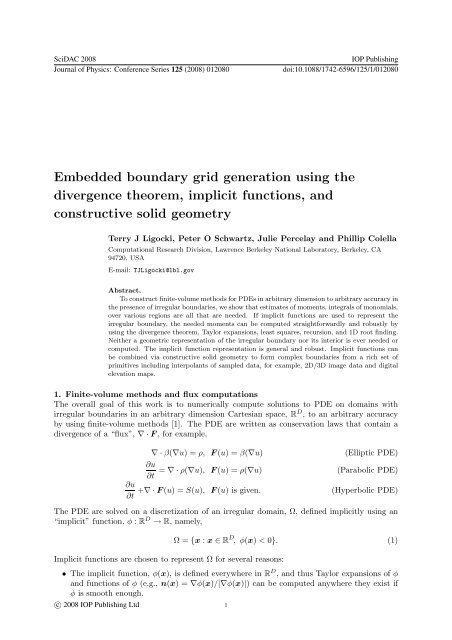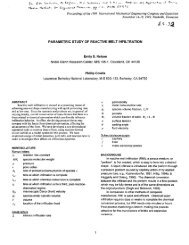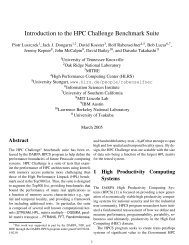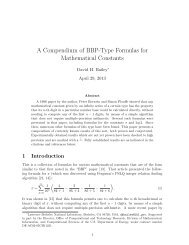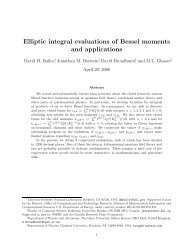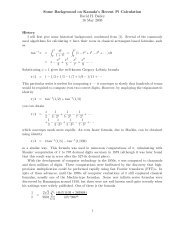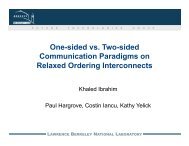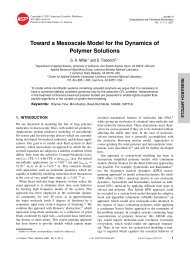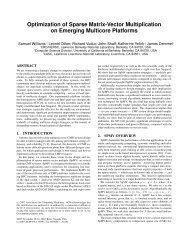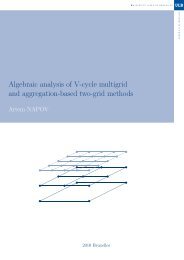Embedded boundary grid generation using the divergence theorem ...
Embedded boundary grid generation using the divergence theorem ...
Embedded boundary grid generation using the divergence theorem ...
Create successful ePaper yourself
Turn your PDF publications into a flip-book with our unique Google optimized e-Paper software.
SciDAC 2008Journal of Physics: Conference Series 125 (2008) 012080IOP Publishingdoi:10.1088/1742-6596/125/1/012080(a) Polynomial function of three variables(b) SF Bay digital elevation map dataFigure 1. Domains generated via an implicit functions.• Implicit functions can be used to represent a rich set of geometric shapes (see figure 1)ei<strong>the</strong>r in functional form or as interpolants of discrete, sampled data (e.g., 2D/3D imagedata [3, 4, 5], digital elevation maps).• Implicit functions can be easily restricted to lower dimensions. This is exploited in <strong>the</strong>algorithm that computes moments (see Section 2).• Implicit functions can be extended to arbitrary dimensions allowing computations to bedone in phase spaces or space-time.• Ω can implicitly evolve in time if φ is allowed to change with time, possibly as a functionof o<strong>the</strong>r PDE variables or time directly.In this embedded <strong>boundary</strong> approach, Ω will be discretized on a set of control volumes, V,formed by intersecting rectangular cells with Ω:V = {[ih,(i + e)h] ∩ Ω : i ∈ Z D }, (2)where e ∈ Z D and all its components are one and h is <strong>the</strong> size of <strong>the</strong> rectangular cells that are,in this case, square.Given this formulation, <strong>the</strong> integral of <strong>the</strong> <strong>divergence</strong> of <strong>the</strong> vector field, ∇ · F, over <strong>the</strong>control volume, V ∈ V, can be transformed by <strong>using</strong> <strong>the</strong> <strong>divergence</strong> <strong>the</strong>orem into an integralover <strong>the</strong> <strong>boundary</strong> of <strong>the</strong> volume, A = ∂V :∫ ∫∇ · F dV = F · n dA (3)Vwhere n is <strong>the</strong> normal to A pointing out of V . In control volumes that do not intersect <strong>the</strong><strong>boundary</strong> of Ω, this can be rewritten as A d −: F − · n = −F d − on <strong>the</strong> low faces and as A d +:F + · n = F d + on <strong>the</strong> high faces by noting that on <strong>the</strong> faces <strong>the</strong> normal points in a coordinatedirection, d. The result is <strong>the</strong> canonical “(sum of) difference in fluxes (integrated over faces)”formulation of finite volume methods. These methods are as accurate as <strong>the</strong> approximations tointegrals of F d ± over <strong>the</strong> faces.2A
SciDAC 2008Journal of Physics: Conference Series 125 (2008) 012080IOP Publishingdoi:10.1088/1742-6596/125/1/012080With <strong>the</strong>se definitions, a finite-volume method for control volumes containing embeddedboundaries can be defined by <strong>using</strong> <strong>the</strong> <strong>divergence</strong> <strong>the</strong>orem:∫V∇ · F dV =∑± = +,−D∑d=1∫± F± d dA +A d ±∫A EBF · n EB dA, (4)where A d ± = {x : x ∈ V,x d = (i d + 1 2 ± 1 2 )h}, A EB = V ∩ ∂Ω, and n EB = ∇φ/|∇φ|. Note: n EBis defined everywhere in Ω and not simply on ∂Ω. This equation has still not been discretized;that is, it is exact. The integrals over <strong>the</strong> <strong>boundary</strong> are discretized by <strong>using</strong> an P th order Taylorexpansion of F and F d ± about points x EB ∈ A EB and x d ± ∈ A d ± that approximate <strong>the</strong> centroidsof <strong>the</strong> domains of integration. In addition, we can expand n EB about some point in <strong>the</strong> cell(which we take to be <strong>the</strong> origin of our coordinates), since it is a known smooth function. Using<strong>the</strong>se Taylor expansions, we can rewrite equation (4) as follows:∫V∇ · F dV =∑0≤|p|≤P(1 ∑p!± = +,−+ ∇ p F ·∑0≤|r|≤RD∑d=1± (∇ p F d ± ) ∫∇ r n EBr!∫A EBA d ±(x − x d ± )r dA(x − x EB ) p x r dA)+ O(h D+P+R .) (5)Assuming F is discretized on <strong>the</strong> rectangular <strong>grid</strong> covered by Ω, one can approximate ∇ p F d ±and ∇ r F to <strong>the</strong> appropriate order by finite differences. The remaining information required isin <strong>the</strong> form of moments, namely, integrals of polynomials computed over <strong>the</strong> V , A d ±, and A EB .Note that x d ± and x EB can also be computed from moments. Computing <strong>the</strong>se is <strong>the</strong> analogue of<strong>grid</strong> <strong>generation</strong> for <strong>the</strong> embedded <strong>boundary</strong> method. No explicit representation of <strong>the</strong> irregular<strong>boundary</strong> is ever needed.2. Moment computationsApproximating <strong>the</strong> needed moments to <strong>the</strong> necessary order can be accomplished by taking allmonomials, x p , of a given degree, P, where p is a multi-index and |p| = P, and substitutingF(x) = x p e d into equation (4), where e d is <strong>the</strong> unit vector in direction d. Note that∂x p /∂x d = p d x p−e dand replacing n EB by its Taylor expansion; <strong>the</strong>n each monomial yields<strong>the</strong> set of D equations defined byp d∫Vx p−e ddV − n d∫A EBx p dA = ∑± = +,−+ ∑∫±1≤|r|≤RA d ±x p dA(∇ r n dr!∫A EBx (p+r) dA)+ O(h D+P+R ) (6)If <strong>the</strong> integrals on <strong>the</strong> LHS are treated as unknowns and <strong>the</strong> RHS is treated as known, <strong>the</strong>n<strong>the</strong> set of equations formed in this way for all monomials x p where |p| = P forms a systemof linear equations. The number of unknowns is N P −1 + N P (where N P is <strong>the</strong> number ofmonomials of degree P) and number of equations is DN P . Since N P −1 < N P , if D ≥ 2, this isan overdetermined system and can be solved by least squares. The one-dimensional case can besolved explicitly by <strong>using</strong> 1D root-finding techniques and integration of monomials (see below).Examining <strong>the</strong> RHS shows that <strong>the</strong> first integral is of <strong>the</strong> same form as <strong>the</strong> volume integrals on<strong>the</strong> LHS except <strong>the</strong> integral has been restricted to one less dimension and <strong>the</strong> monomial degree3
SciDAC 2008Journal of Physics: Conference Series 125 (2008) 012080IOP Publishingdoi:10.1088/1742-6596/125/1/012080(a) Borromean (interlocked) rings(b) Gas jet nozzleFigure 2. Domains generated via constructive solid geometry and multiple implicit functions.is one more. Hence, <strong>the</strong> order of accuracy is <strong>the</strong> same, ((P + 1) + (D − 1) + R = P + D + R).Using recursion, we can reduce <strong>the</strong> dimension until D = 1. At this point all <strong>the</strong> moments canbe computed over A d because A d is <strong>the</strong> intersection of V with a line parallel to <strong>the</strong> x d axisand <strong>the</strong> monomial only has one variable that isn’t constant. The intersection can be found by<strong>using</strong> robust 1D root finding algorithms to get <strong>the</strong> end points of <strong>the</strong> 1D integral, which is <strong>the</strong>ncomputed explicitly.The second integral on <strong>the</strong> RHS involves moments over <strong>the</strong> A EB in <strong>the</strong> current dimensionbut <strong>the</strong> degree has increased to P + |r|. Thus, <strong>the</strong>y can be computed recursively. The recursionterminates because as <strong>the</strong> degree of <strong>the</strong> monomial moments increases, <strong>the</strong> dimension and orderof accuracy stays <strong>the</strong> same. Thus, <strong>the</strong> value of R (<strong>the</strong> number of terms in <strong>the</strong> Taylor series) in<strong>the</strong> recursion decreases by |r|. Eventually, <strong>the</strong>re are no terms of <strong>the</strong> Taylor series on <strong>the</strong> RHSso this recursion terminates.Overall, <strong>the</strong> algorithm proceeds by setting up <strong>the</strong> equations to compute <strong>the</strong> needed momentsover <strong>the</strong> needed regions as a least squares problem. Then <strong>the</strong> RHS is recursively computedrecursing in both dimension and monomial degree. Finally, <strong>the</strong> original least squares problemsare solved for <strong>the</strong> unknown moments, and <strong>the</strong>se are used in <strong>the</strong> flux computations. Since <strong>the</strong>least squares problems are always well conditioned and <strong>the</strong> only computations involving <strong>the</strong> Ωare <strong>the</strong> intersections of <strong>the</strong> Ω with lines parallel to <strong>the</strong> coordinate axes, this algorithm is veryrobust and straightforward to implement.3. Complex irregular boundariesIn order to construct more complex irregular boundaries, implicit functions can be composed intomore complex implicit functions <strong>using</strong> constructive solid geometry, CSG. To do so, one mustdefine <strong>the</strong> complement, intersection, and union of irregular domains, Ω i , defined by implicitfunctions, φ i . To this end we use <strong>the</strong> following correspondences.Ω complementi⇔ −φ iΩ intersection ⇔ max φ i iΩ union ⇔ min φ i i4
SciDAC 2008Journal of Physics: Conference Series 125 (2008) 012080IOP Publishingdoi:10.1088/1742-6596/125/1/012080Fur<strong>the</strong>r, coordinate transformations, ψ, of Ω can be implemented asΩ ψ = {x : x ∈ R D , φ(ψ −1 (x)) < 0}.Examples of ψ include rotations, translations, and scaling. In addition to being straightforwardto implement by <strong>using</strong> implicit functions, CSG is a very robust and intuitive method for buildingcomplex geometry objects and easily manipulating <strong>the</strong>m (see figure 2).Once constructed, only <strong>the</strong> value of <strong>the</strong> implicit function representing <strong>the</strong> irregular domainand its derivatives need to be evaluated in order to compute <strong>the</strong> necessary moments. This allows<strong>the</strong> embedded <strong>boundary</strong> method to perform efficiently even on workstations.If good estimates of <strong>the</strong> bounds of <strong>the</strong> local Taylor series expansion of <strong>the</strong> implicit functionsare available, <strong>the</strong>se can be used to dramatically improve performance by subdividing spacerecursively and only evaluating <strong>the</strong> implicit function where an irregular <strong>boundary</strong> could exist,i.e., regions where φ(x) could be zero. Thus, <strong>the</strong> amount of work done is proportional to <strong>the</strong>number of cells containing <strong>the</strong> irregular <strong>boundary</strong> and not <strong>the</strong> entire space. This also allowscells with under resolved geometry to be detected and corrected by adaptively refining <strong>the</strong>secells. This has been found to occur routinely when <strong>the</strong> higher-dimension irregular domains arerestricted to lower dimensions; for example, slices of a well-resolved unit sphere can be circleswith arbitrarily small radii. Once adequate refinement has been done, ei<strong>the</strong>r <strong>the</strong> computationcan use <strong>the</strong> refined computational cells, or <strong>the</strong>y can be coarsened to provide <strong>the</strong> moments at <strong>the</strong>original resolution.4. Conclusions and future workIt has been shown that finite volume methods for PDE can be done in arbitrary dimensionto arbitrary accuracy in <strong>the</strong> presence of irregular boundaries by computing moments, integralsof monomials, over various regions. If <strong>the</strong> irregular <strong>boundary</strong> is defined by implicit functions,computing <strong>the</strong>se moments can be computed <strong>using</strong> <strong>the</strong> <strong>divergence</strong> <strong>the</strong>orem, Taylor expansions,least squares, recursion, and 1D root finding. As a result, an explicit representation of <strong>the</strong>irregular domain and <strong>boundary</strong> is never needed nor computed. The resulting computationsare robust and efficient even for complex domains which can be easily defined <strong>using</strong> implicitfunctions and constructive solid geometry.These methods can be extended to mapped <strong>grid</strong>s by incorporating coordinate mappings in <strong>the</strong>flux and moment computations. In addition, <strong>the</strong>se methods can be used in any computationalcontext where <strong>the</strong> algorithm can be reduced to <strong>the</strong> computation of moments over irregulardomains or boundaries, for example, <strong>the</strong> integration of functions over <strong>the</strong>se regions.AcknowledgmentThis research was supported by <strong>the</strong> Office of Advanced Scientific Computing Research of <strong>the</strong>US Department of Energy under contract number DE-AC02-05CH11231.References[1] Colella P 2001 Volume-of-fluid methods for partial differential equations Godunov Methods: Theory andApplications E F Toro, 161–177[2] Aftosmis M, Berger M J and Melton J 1998 Robust and efficient Cartesian mesh <strong>generation</strong> for componentbasedgeometry AIAA J. 36(6) 952–960[3] Deschamps T, Schwartz P, Trebotich D, Colella P, Malladi R and Saloner D 2004 ‘Vessel segmentation andblood flow simulation <strong>using</strong> level sets and embedded <strong>boundary</strong> methods (Elsevier International CongressSeries, 1268) 75–80[4] Schwartz P, Adalsteinsson D, Colella P, Arkin, A P and Onsum M 2005 Numerical computation of diffusionon a surface Proc. Nat. Acad. Sci. 102 11151–11156[5] Malladi R, Sethian J A and Vemuri B C, Shape modeling with front propagation: A level set approach IEEETrans. Pattern Anal. Machine Intell. 17:158–175.5


